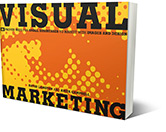Because, if they don’t open your emails, they’ll never see the great visuals.
 We’re all about using visuals to communicate. But it’s not just about the pictures, it’s about the idea, the concept and the content behind the visuals that will make your marketing effective. With that in mind we’d like to share 5 surprisingly easy tips on creating the best email marketing Subject Titles. Because, if they don’t open your emails, they’ll never see the great visuals.
We’re all about using visuals to communicate. But it’s not just about the pictures, it’s about the idea, the concept and the content behind the visuals that will make your marketing effective. With that in mind we’d like to share 5 surprisingly easy tips on creating the best email marketing Subject Titles. Because, if they don’t open your emails, they’ll never see the great visuals.
1. Creativity
Creative headlines are often the best way to attract attention…but where do you come up with new ideas? You can try this fun tool: Link Bait Generator. You can type in subjects and it will automatically generate a clever headline adaptation. Brian Massey from Conversion Scientists was inspired by the seminar names at the SXSW Conference and provides this advise, “If our email is to be read, our subject lines must save our recipients from mindless autonomy.” Here are highlights from Brian’s keys to creative email title writing. Read the original post here.
Things That Don't Fit Together: Non-Sequiturs
Our brains are wired to discard the familiar faster than a bear can spell Constantinople. It is the unexpected that gets the attention of our conscious and prepares us for action. These titles demonstrate the use of twists to pull readers out of their inbox apathy.
Lists of Three
There is something memorable, readable, and easy-to-count about lists of three. This method is especially successful when the third item is overly specific or doesn't fit. See "Things that Don't Fit Together" above. (For the Langton Cherubino blog, our subject title “Pinterest, Donuts and Social Networking” worked quite well scoring the second highest open rate in the past 6 months.)
Shock and Awe
Boring subject lines make me want to poke needles into my eyes! Sometimes it makes sense to hit readers over the head with something that is just plain shocking. Sometimes.
Rhymes and Alliteration
Sensual subject lines supplement the bottom line. Alliteration is the repeated use of consonants. Rhymes grab your readers like a musical phrase. Don't be afraid to add a little poetry to your prose.
Metaphors and Similes
Similes are like can openers for the mind. Metaphors are the batteries in the flashlight of your email. The technical term for this style of messaging is "transubstantiation," using the characteristics of one thing to add meaning to another in the eyes of the reader.
2. Expectations
One of the best tips we’ve seen is to set the right expectations. Are you sending out content that meets the expectations of your subscribers? Do your subscribers expect sales offers, coupon promotions and special discounts like many retail companies? Or do they expect breaking news? Industry expertise? Interesting and unusual content on subjects that you are an expert in? Do you provide content that is relevant to your clients and supports your organizations goals? It’s important to be clear about what type of content you are delivering so that your Subject Titles can reflect that.
3. Authenticity
You want to establish a long-term relationship with your subscribers as a reliable and interesting source for important content. As the marketers at VerticalResponse say: “Your ‘From Label’ is very important.” Use your organization’s name in the ‘From’ section of the email and it’s a good practice to repeat it in the actual title of the email. We found that when we put “Langton Cherubino” in the Subject Title it was our highest “open rate.” You don’t want to hide or trick the user about who is sending out the email. Gimmicks and tricks may work to give you a temporary bump in the “open rate” of your emails, but in the long run this diminishes your credibility. It is better to be authentic than to come across as too salesy. MailChimp warns that “Most people get so much junk mail in their inbox, anything that even hints of spam gets thrown away immediately.”
4. The Fundamentals:
The next two tips are from Brian Clark, founder of Copyblogger. When you’re writing your next subject line, run it through this checklist, based on the Four “U” Approach to headline writing:
• Useful: Is the promised message valuable to the reader?
• Ultra-specific: Does the reader know what’s being promised?
• Unique: Is the promised message compelling and remarkable?
• Urgent: Does the reader feel the need to read now?
When you’re trying to get someone to take valuable time and invest it in your message, a subject line that properly incorporates all four of these elements can’t miss. And yet, execution in the email context can be tricky, so let’s drill down into subject-line specifics for greater clarity.
5. The Specifics:
Beyond headline fundamentals, these are the things to specifically focus on with email subject lines:
• Urgent when it’s useful: When every message from you is urgent, none is. Use urgency when it’s actually useful, such as when there’s a real deadline or compelling reason to act now. If you’re running your email marketing based on value and great offers, people don’t want to miss out and need to know how much time they have.
• Rely on spam checking software: We all know that certain words trigger spam filters, but there’s a lot of confusion out there about which words are the problem. Is it okay to use the word “free” in a subject line? Actually, yes. All reputable email services provide spam checking software as part of the service or as an add-on. Craft your messages with compelling language, let the software do its job, and adjust when you have to.
• Shorter is better: Subject line real estate is valuable, so the more compact your subject line, the better. Don’t forget useful and ultra-specific, but try to compress the fundamentals into the most powerful promise possible.
More Subject Title Resources:
7 Tricks for the Best Email Subject Lines
14 Email Subject Line Hacks
11 All-Time Great Retail Subject Lines
Email Subject Line Comparisons



